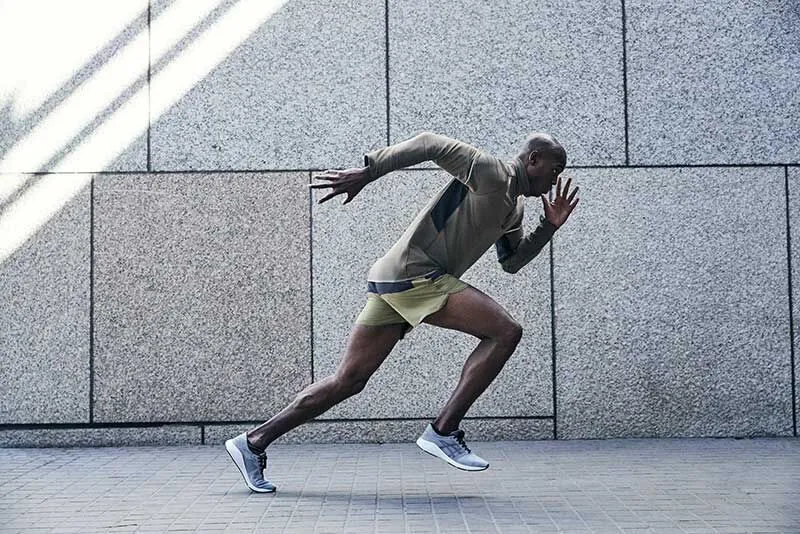
Tennis training exercises – Drills away from the court
October 8, 2022
Looking to gain that extra edge at your next game? Here are a few tennis exercises you can do away from the court to build fitness, strength and help alleviate the symptoms of tennis elbow.
Looking to gain that extra edge at your next game? Here are a few tennis exercises you can do away from the court to build fitness, strength and help alleviate the symptoms of tennis elbow.

FITNESS AND SPEED
Getting around the court for the full three or five sets without your performance dropping takes real stamina. If you don’t have the base level of fitness, the rest of your game will suffer – tired players can’t play as powerfully or accurately.
So, here are a few tennis exercises to boost your fitness and increase your speed away from the court so you’re ready to chase down every ball.
Shuttle sprints
This exercise helps to develop short bursts of speed, which are essential if you’re a serve-and-volley player.
- Run to a point 10 metres away
- Turn and sprint back to the start line
- Run to a point 20 metres away
- Turn and sprint back to the start line
You can repeat this exercise with short breaks in between each rep.
Ball retrieval
This exercise helps to build your speed and stamina and makes you more flexible, too.
- Spread out tennis balls around a patch of grass
- Sprint to pick each one up and return to the starting point
You can track your progress by timing yourself and trying to beat your personal best.
Interval running
This tried and tested tennis exercise is a favourite of runners everywhere. It will help you to build up speed and stamina with short bursts of sprinting sandwiched between running at a slower pace.
- Run at your relaxed pace for three minutes
- Sprint for 200 metres
Repeat this as many times as feels comfortable.
Get the most out of your training with a good pair of running shoes. For speed training, you should go for a lightweight shoe that’s designed to help you run as fast as possible. Check out the ASICS GEL-DS TRAINER™ for men and women. It features lightweight FLYTEFOAM™ technology in the midsole for a snappy response and the PROPULSION TRUSSTIC™ system in the shoe’s outsole, which mirrors the foot’s ligaments to propel your stride.

STRENGTH
While fitness training helps you get around the court, strength training will help you win the point. Here are a few tennis exercises you can try to improve your lower and upper body strength
X band walks
This tennis exercise builds up your leg strength and improves your side-to-side movement along the baseline. You’ll need a resistance band to do it.
- Stand with both feet on the resistance band
- Hold one end in each hand and cross them over so they make an X shape
- Keep a high tension on the band and step to the right 10 times
- Then, step to the left 10 times
It looks easy, but it’s actually a very hard exercise to do. Your leg muscles will feel stronger for it though, and once you’re on the court, you’ll feel more nimble.
Glute bridges
This helps you build up explosive bursts of speed – perfect for getting to drop shots quickly.
- Lay flat on your back with your arms to the side
- Bend your knees at a 90-degree angle
- Lift your hips up so that only your shoulders and feet are on the ground
- Repeat 10 times
Medicine ball workouts
The medicine ball is the number one piece of equipment for upper body strength training. There are lots of different tennis exercises that use it, here’s one you could try.
- Stand with your side to a wall about one metre away
- Throw the ball sideways against the wall and catch the rebound
- Repeat 10 times
Remember to make sure the wall you’re working out against is strong enough to handle the medicine ball!
Get the most out of your strength training exercises with a good pair of running shoes. The ASICS GEL-QUANTUM 180™ is a trainer that’s built for strength. With 180 degrees of GEL™ technology cushioning in the midsole, it provides the cushioning you need for high-impact exercises and delivers sturdy support, especially during lateral movements. It’s also lightweight and comfortable while being durable enough to handle weights training sessions, CrossFit workouts and cardio classes.
TENNIS ELBOW EXERCISES
Lateral epicondylitis, also known as tennis elbow, is a painful condition that often occurs after strenuous use of the muscles and tendons of the forearm, near the elbow joint. Those are the same muscles and tendons used when playing tennis, which is why keen tennis players are at higher risk. As the same muscles and tendons are used over and over again, they can become inflamed and damaged, which leads to pain and tenderness on the outside of the elbow.
Tennis elbow is a self-limiting condition, which means it will eventually get better without treatment. However, there are some exercises you can do to improve your symptoms and speed up your recovery.
What exercises help tennis elbow?
Effective tennis elbow exercises include:
Fist clench
Poor grip strength is a common symptom of tennis elbow. Improving your grip strength will reduce these symptoms and help you perform on the court.
- Sit with your forearm resting on a table
- Hold a rolled-up towel or small ball in your hand
- Squeeze the ball or towel as hard as you can and hold it for 10 seconds
- Repeat 10 times before switching to the other arm
Supination with a dumbbell
The supinator is a large muscle in the forearm that attaches to the elbow and is often involved in movements that cause tennis elbow. Strengthening this muscle will help to reduce the symptoms of tennis elbow and reduce the likelihood of similar injuries in the future. All you’ll need is a one-kilogram dumbbell.
- Sit on a chair and hold the dumbbell vertically in your hand with your elbow resting on your knee
- Keep your upper arm and elbow still and let the weight of the dumbbell rotate the arm outward so the palm of your hand is facing upward
- Rotate the hand back the other direction until your palm is facing downward
- Repeat 20 times on each side
You should always consult a doctor before doing tennis elbow exercises and have a full evaluation to rule out more serious injuries such as muscle or tendon tears.
Want some help finding the right running shoes for speed and strength tennis exercises? Then take a look at our speed vs. stability tennis shoe guide.


